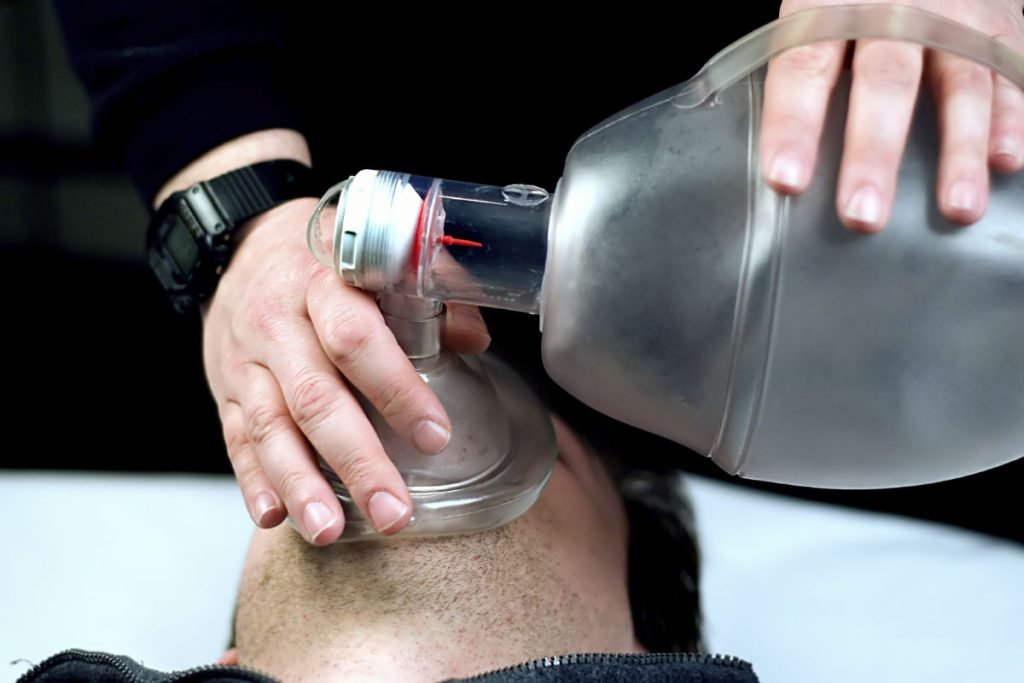Understanding the Critical Role of Air Volume in BVM Ventilation
Bag-valve-mask (BVM) ventilation serves as a cornerstone of emergency respiratory support. Healthcare providers must understand proper air volume delivery to ensure patient safety and optimal outcomes. The role of air volume in successful BVM ventilation directly impacts patient survival and recovery rates during critical situations.
Effective BVM ventilation requires precise control of tidal volumes. Too little air fails to provide adequate oxygenation. Too much air can cause gastric insufflation, barotrauma, and cardiovascular compromise. Understanding these principles helps healthcare providers deliver life-saving ventilation safely and effectively.
Volume of Air to Deliver During BVM Ventilations
Recommended Tidal Volumes for Adults
Research from the National Center for Biotechnology Information shows that the tidal volume needed for an adult is typically 500 to 600 mL, although the bag can deliver up to 1600 mL if fully compressed. The American Heart Association guidelines support this recommendation, stating that enough tidal volume to cause visible chest rise, or approximately 500 to 600 mL, provides adequate ventilation while minimizing the risk of overdistension or gastric insufflation.
Healthcare providers should focus on delivering controlled volumes rather than maximum bag compression. For each breath, steadily and smoothly squeeze the bag to deliver a tidal volume of 6 to 8 mL/kg (or about 500 mL for an average-sized adult) over 1 second, according to the Merck Manual Professional Edition.
Weight-Based Calculations
Modern medical practice emphasizes weight-based tidal volume calculations for optimal patient care. To achieve lung-protective ventilation for intubated patients, the average tidal volume should be between 5–8 milliliters per kilogram (mL/kg) of ideal body weight. This approach ensures personalized ventilation that accounts for individual patient anatomy and physiology.
For a 70-kilogram adult, the ideal tidal volume ranges from 350 to 560 mL. However, clinical studies reveal that the adult BVM provided a mean tidal volume of 807.7mL versus the pediatric BVM providing 630.7mL, both of which exceeded the upper threshold of 560mL. This finding highlights the importance of controlled bag compression techniques.
What is the Volume of Air During BVM Ventilation?
Understanding BVM Reservoir Capacity
BVM devices contain significantly more air than required for single breaths. The reservoirs of adult BVMs contain between 1500–2000 mL of air, depending on the manufacturer and model. This large capacity allows for multiple ventilations without refilling, but it also increases the risk of over-ventilation if providers compress the entire bag.
Healthcare training emphasizes the importance of partial bag compression. The average volume of an adult BVM is 1600 milliliters! Squeezing the bag until the opposite sides of the BVM touch isn’t necessary! It’s recommended that only 1/3 of the bag be compressed to give a large enough tidal volume.
Monitoring Adequate Air Volume Delivery
Successful BVM ventilation requires visual confirmation of chest rise and fall. The bag should be squeezed only until a visible chest rise occurs, typically about one-third full. This visual cue serves as the primary indicator of adequate air volume delivery during emergencies.
Healthcare providers must balance adequate ventilation with safety considerations. The tidal volume associated with detectable chest wall movement is estimated to be between 300 and 500 mL, providing a margin of safety while ensuring effective oxygenation.
Most Effective Ways to Deliver Bag Mask Ventilation
Two-Handed Technique for Optimal Seal
The American Heart Association recommends specific techniques for effective BVM ventilation. Ventilation should be provided using a BVM with 100% O2 and a HEPA filter attached to the exhalation port of the breathing device using a two-handed mask technique to obtain a tight mask seal. This approach maximizes air delivery efficiency while minimizing air leaks.
Two-person BVM operation often produces superior results compared to single-person attempts. One provider maintains the mask seal while another controls bag compression, ensuring consistent air volume delivery and proper ventilation timing.
Controlled Compression Techniques
Proper bag compression technique significantly impacts air volume delivery effectiveness. The bag should be squeezed slowly, as rapid squeezing increases the risk of gastric insufflation and reduces ventilation efficiency. Controlled, steady compression over one second ensures optimal air distribution throughout the lungs.
Healthcare providers must avoid excessive force during bag compression. If using a 1000-mL volume bag, squeeze only halfway to deliver the correct tidal volume. This measured approach prevents over-ventilation while maintaining adequate oxygenation levels.
Timing and Rate Considerations
Ventilation timing plays a crucial role in successful BVM air volume delivery. Emergency protocols recommend 8-10 breaths per minute for adults with pulse, allowing adequate time for chest recoil between breaths. This timing ensures proper venous return and maintains cardiovascular stability during ventilation.
Research indicates that the mean ventilation parameters include a tidal volume of 599.70 ml, peak pressure of 26.35 cmH2O, and flow rate of 77.20 l/min among experienced respiratory therapists. These parameters provide benchmarks for effective BVM ventilation performance.
Safety Considerations and Pressure Limits
Pressure-Limiting Valves
Modern BVM devices incorporate safety features to prevent excessive pressure delivery. The International Organization (ISO) recommends that BVM resuscitators be equipped with a mechanism to prevent airway pressures from exceeding 45–60 cmH2O. These pressure-limiting valves protect patients from barotrauma while maintaining effective ventilation capabilities.
Healthcare providers should understand when pressure-relief valves activate and how they affect air volume delivery. A pop-off valve (releases at about 60 cmH2O) to give increased pressure in the circuit ensures patient safety during high-pressure ventilation scenarios.
Preventing Over-Ventilation Complications
The role of air volume in successful BVM ventilation includes preventing harmful over-ventilation effects. Excessive air volumes can cause gastric distension, reduce cardiac output, and increase intrathoracic pressure. Healthcare providers must maintain awareness of these risks while delivering life-saving ventilation.
Proper technique training emphasizes gradual air volume increase until a visible chest rise occurs. This approach minimizes complications while ensuring adequate oxygenation for patient survival and recovery.
Training and Competency Development
Healthcare providers require regular training to maintain BVM ventilation competency. Understanding the role of air volume in successful BVM ventilation involves both theoretical knowledge and practical skills development. Hands-on practice with feedback helps providers develop proper compression techniques and air volume control.
Simulation-based training allows healthcare providers to practice BVM ventilation scenarios safely. These training sessions emphasize proper air volume delivery, timing, and troubleshooting common ventilation problems that occur during emergencies.
Conclusion
The role of air volume in successful BVM ventilation cannot be overstated in emergency healthcare. A proper understanding of tidal volume requirements, compression techniques, and safety considerations ensures optimal patient outcomes during critical situations. Healthcare providers must maintain current knowledge and practical skills to deliver effective BVM ventilation consistently.
Successful BVM ventilation requires precise control of air volume delivery combined with proper technique and patient assessment. By following evidence-based guidelines and maintaining regular training, healthcare providers can master this essential emergency skill and improve patient survival rates.
Frequently Asked Questions
- What is the correct air volume for BVM ventilation in adults?
The recommended tidal volume for adult BVM ventilation is 500-600 mL, or approximately 6-8 mL per kilogram of ideal body weight. This volume should produce a visible chest rise without causing gastric insufflation or barotrauma.
- How much of the BVM bag should I compress during ventilation?
Healthcare providers should compress only about one-third of the BVM bag to deliver appropriate tidal volumes. Full bag compression can deliver up to 1600 mL, which far exceeds recommended volumes and increases complication risks.
- What are the signs of proper air volume delivery during BVM ventilation?
Proper air volume delivery produces visible chest rise and fall, adequate oxygen saturation levels, and absence of gastric distension. The chest should rise smoothly with each breath and fall completely between ventilations.
- How does BVM air volume differ between adults and pediatric patients?
Adult patients require 500-600 mL tidal volumes, while pediatric patients need 6-8 mL per kilogram of ideal body weight. Pediatric BVM bags typically deliver smaller volumes but may still exceed optimal ranges if fully compressed.
Take Action: Enhance Your BVM Ventilation Skills Today
Master the role of air volume in successful BVM ventilation through professional certification training. CPR Columbus offers comprehensive BLS certification in Columbus programs designed for healthcare providers and emergency responders.
Our American Heart Association training site provides hands-on, stress-free instruction in BLS for Healthcare Providers, ACLS, PALS, and CPR and First Aid courses. Learn proper BVM techniques, air volume control, and advanced life support skills from experienced instructors.
Contact CPR Columbus today to schedule your certification or renewal training. Develop the confidence and competency needed to deliver life-saving BVM ventilation in any emergency. Your patients depend on your skills – make sure they’re the best they can be.





